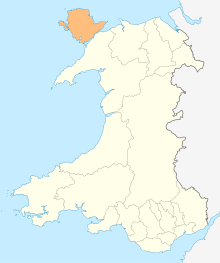Afon Braint
Afon Braint (English: River Braint) is a small tidal river on Anglesey, North Wales. There is a series of stepping stones near to the village of Dwyran, and a Grade II bridge near Penmynydd.
| Afon Braint | |
|---|---|
 The stepping stones across Afon Braint | |
 Location of the mouth | |
| Native name | Afon Braint |
| Location | |
| Country | Wales |
| Physical characteristics | |
| Source | Pentraeth |
| ⁃ coordinates | 53°17′4″N 4°9′57″W |
| Mouth | Menai Strait |
⁃ coordinates | 53°8′52″N 4°20′18″W |
Description
Afon Braint is a river in the south of the island of Anglesey, North Wales.[1] Its primary source is Llyn Llwydiarth, (coordinates: 53.283884, -4.178133), a lake on Mynydd Llwydiarth, within the Pentraeth Forest, east of Penraeth, and south-west of Llanddona.
This river is unusual, in so far as it has two estuaries; Both flow into the Menai Strait to the south of the island. The river splits near Llanfairpwllgwyngyll (at coordinates: 53.219124, -4.228168), where one branch flows briefly eastwards, then south into the Menai Strait at Pwllfanogl (at coordinates: 53.215660, -4.202717).
The other main branch of Afon Braint flows south westward from Llanfairpwllgwyngyll, towards Brynsiencyn, parallel and to the north of the A4080 road until Dwyran, where it turns south-west, passing beneath the road, flowing into the Menai Strait at Traeth Abermenai, east of Newborough Warren, near Pen-Lôn. At this terminus, Afon Braint is a tidal river (coordinates: 53.147763, -4.336195).
In modern Welsh, the word 'braint' means, 'privilege, prerogative, birthright; honour, dignity, blessing; status, position, rank, value, state; right, freedom, liberty',[2] however the river name is thought to derive from Brigantia, a goddess in Celtic (Romano-British and Gallo-Roman) religion of Late Antiquity.[3]
The prehistoric Bryn Celli Ddu, considered to be one of Wales's finest passage graves,[4] is located 200 metres (660 ft) from the river.[5] Near to the village of Dwyran, there is a series of large limestone stepping stones across the river.[1] There is a Grade II listed bridge in close proximity to Penmynydd.[6]
In 2004, the river flooded causing disruption to the train services on the Holyhead to Chester line at the Llanfairpwllgwyngyll crossing.[7] A tugboat has been named after the river; the Afon Braint was delivered to the Holyhead Towing Company in April 2005.[8]
Notes
- Plant 2014, p. 82.
- http://www.geiriadur.ac.uk/
- Hughes, Kristoffer. The Book of Celtic Magic: Transformative Teachings from the Cauldron of Awen. Llewellyn Worldwide, 8 Aug 2014.
- coflein NPRN: 93827, RCAHMW, accessed 12 June 2014
- Cummings & Whittle 2004, p. 51.
- "Bridge over the Afon Braint, Penmynydd". British Listed Building. Retrieved 16 April 2016.
- Jones, Ceri (16 October 2004). "Brace Yourself for Wet Wednesday". Western Mail. Archived from the original on 29 May 2016. Retrieved 16 April 2016 – via HighBeam Research.
- "'Afon Braint' - the Latest of a Successful Breed". Maritime Journal. 1 May 2005. Retrieved 16 April 2016.
References
- Cummings, Vicki; Whittle, A.W.R. (2004). Places of Special Virtue: Megaliths in the Neolithic Landscapes of Wales. Oxford: David Brown Book Company. ISBN 978-1-84217-108-0.CS1 maint: ref=harv (link)
- Plant, Steve (2014). A Wander Around Wales. Peterborough: FastPrint Publishing. ISBN 978-1-78035-761-4.CS1 maint: ref=harv (link)
